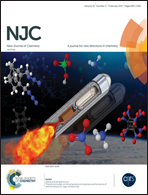Designed C3N4/CdS–CdWO4 core–shell heterostructure with excellent photocatalytic activity†
Abstract
C3N4/CdS–CdWO4 core–shell heterostructure photocatalysts were prepared via a facile solvent volatilization method. High-resolution transmission electron microscopy (HRTEM) analysis demonstrated that an interfacial structure was present between the C3N4 shell and the CdS–CdWO4 core, and the specific function of the modification of C3N4 was investigated by room-temperature photoluminescence spectroscopy and transient photocurrent measurement. The heterostructure photocatalysts displayed enhanced photocatalytic activity in the degradation of RhB dye than that of the single components and binary composites. Among the as-prepared samples, the best photocatalytic performance was achieved by 10 wt% C3N4/CdS–CdWO4, which was about 5.7 and 14.6 times that of CdS–CdWO4 and C3N4, respectively, under UV-visible light irradiation. Owing to the formation of a C3N4/CdS–CdWO4 ternary heterostructure, its efficient pollutant-removing ability and stability can be attributed to the improved separation of photogenerated carriers and transfer efficiency for the intensive built-in electric field intensity. Radical trapping experiments proved that h+ and ˙O2− play crucial roles in the photocatalytic process.



 Please wait while we load your content...
Please wait while we load your content...